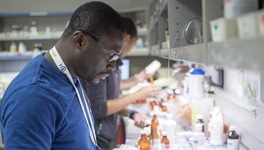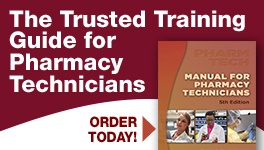Primary Intended Outcomes
- Ensure patients were not without critical medications within initiation of their hospital stay.
- Improve interdisciplinary work flow and patient safety by involving pharmacy technicians and pharmacy interns in medication reconciliation.
Relevant PPMI Recommendation
D10: Opportunities for technician specialization should be developed
Situation Analysis
In 2005, The Joint Commission (TJC) identified medication reconciliation as National Patient Safety Goal (NPSG) number 8. In 2011, TJC revised requirements to medication reconciliation. There- fore, it was imperative to look for a better way to capture patient medication histories in order to avoid medication errors such as omissions, dupli- cations, drug interactions, or dose errors.
Previously, Northwest Medical Center in Tucson, Ariz., tasked nurses with conducting medication reconciliation. Nursing staff filled out a form, but they would sometimes be incompletely filled out or be missing information regarding medication name, indication, or dose. The pharmacy depart- ment proposed utilization of pharmacy techni- cians and interns, with pharmacist supervision, for medication history review.
Service Description
With this project in place, nurses would take all patient medication histories initially upon admis- sion. Once the medication list of the patient was established, a specially trained pharmacy techni- cian or intern would review it and check for com- pleteness and accuracy. They would then compare that list with the medications ordered by the physician to continue necessary home medica- tions. Upon review, they would make recommen- dations to medical providers to re-order critical medications that were missed.
Technicians and interns were trained about the list of critical medications developed by the Pharmacy and Therapeutics Committee that patients should not be without for more than 48 hours. Some of these critical medications include anticoagulation, cancer medications, and anti-seizure medications. If the initial list was not complete or the techni- cian/student felt that not enough information about the patients’ medications were given, tech-nicians and interns would follow up with the patient, patient’s family, home pharmacy, or pri- mary care physicians to verify the medications .
When a change needed to be made that was identified by the technicians or the interns, the pharmacist would check it and either leave a note in the chart or call the physician. Then, an assess- ment was made of which physician group (hospi- talists, specialists or surgeons) was most accepting of medication reconciliation-related recommendations.
Key Elements for Success
- The hospital administration was completely supportive of the implementation of the collaborative effort to take over medication reconciliation.
- The first pharmacy technician who participated in this had more than 30 years of experience and was looking to do more as a technician.
- Physicians and nurses within the medical system were receptive to ideas and recommendations.
- A dedicated workspace is important
Resource Utilization
Personnel: Nurses, physicians, pharmacists, phar- macy technicians, and interns were all involved in the process. The technicians and interns were scheduled from 8:00 a.m. to 4:30 p.m. As the pro- gram progressed, more technicians and interns were trained to conduct medication reconcilia- tion. However, no new staff members were hired just to perform medication reconciliation.
IT and other infrastructure: Medication reconcili- ation was performed using a specific form with space for the medication name, dose, direction, the source of the information, and who collected it. This form eventually evolved into an order form that allowed the prescriber to check a box stating if they wanted to continue or discontinue a medication. This required an additional “adden- dum” form that allowed updating the medication history because the original one was now a physi- cian order that could not be altered by the techni- cian or intern.
Supply expense: As this initiative grew, more technician hours were added, and a raise was given to technicians who added on this responsi- bility. However, the significance of the cost is cur- rently unknown.
Return on investment: A review of the program was conducted two years after its start. Just over 1,240 patients who received medication reconcilia- tion services during the study period had at least one “critical medication” in their current medica- tion history. Although the majority of patients (89.3 percent) did not require interventions, phar- macists made 178 interventions on 132 patients.
Ten percent of patients needed medication rec- ommendations; out of those, 57 percent of rec- ommendations were accepted by the ordering physician. Clearly, the percentage indicates that potential errors were avoided. The most common medications for which pharmacists made recom- mendations (primarily, anticonvulsants, antide- pressants, thyroid medications, and vitamin K antagonists) were recorded. Another benefit of this program was the additional time it freed up for nurses and physicians to engage in other patient-care activities.
Recognized Intangible Benefits
Because of pharmacists’ knowledge base and extensive training, medication reconciliation should be a pharmacy-driven process. Utilizing highly trained pharmacy technicians and student interns to assist in this process is a smart use of health-system resources. The success of the pro- gram at Lincoln Hospital was evidenced by the fact that, since its inception, two other techni- cians have been added to the staff rolls. They have been trained on the critical medications, common doses, what errors to look for, and the ability to ask patients open-ended questions.
Outcome Measures
- Recommendations for thyroid medications were most highly accepted (82.1 percent), fol- lowed by anticonvulsants (63.2 percent), other medications (55.6 percent) and antidepres- sants (54.8 percent).
- 102 out of 178 recommendations (57 percent) made from May to June 2010 were accepted by medical providers.
- We also examined which types of physicians were most likely to accept our recommenda- tions. Hospitalists were most likely to accept, followed by specialists, and surgeons.
Lessons Learned
- Talking with the patient is the most important part of collecting medication histories. You can contact his or her home pharmacy, but the
patient may not be taking the medication exactly as prescribed. Patients can provide you with more information than a pharmacy or pri- mary care physician’s office. Alternatively, the patient may not be able to give you all of the information you need. However, it is important to try to get as much information as you can from all of the resources that you can.
- Throughout the project, cumbersome paper charts were used. The medication history that you see may look complete to the technician, intern, and pharmacist, but the patient may be on medications that you don’t know of. As such, electronic charts may be an easier way to gather and transfer information between divi- sions of the hospital.
Suggestions for Other Hospitals/Health Systems
Deploying pharmacy technicians on a project like this is a great utilization of existing resources.
They have knowledge and are able to get trained on the necessary tools needed to conduct these medication reconciliations. The technicians in our pharmacy who were approached to participate were very excited about going out and seeing patients and working on this project.
Technicians were trained to recognize the critical medications as well as the dosage range. The technicians also received training on how to inter- view a patient, ask open-ended questions, and how to gather information from a patient’s chart. Student interns received most of this training dur- ing their first year of pharmacy school, and they did not start with the medication reconciliation program until the second year. The pharmacy director shadowed each technician and intern to verify their skills before they were allowed to function independently.
The technicians in this program were highly moti- vated, independent individuals with a history of developing or helping out with major projects.
Another “incentive” was a set Monday to Friday schedule, with interns providing weekend cover- age for the majority of the time.
References
- Nester TM and Hale LS. Effectiveness of a phar- macist-acquired medication history in promot- ing patient safety. Am J Health Syst Pharm. 2002; 59:2221-25.
- Reeder TA and Mutnick A. Pharmacist- versus physician-obtained medication histories. Am J Health Syst Pharm. 2008; 47(1):35-42.
- Lubowski TJ, Cronin LM, Pavelka RW et al. Effectiveness of a medication reconciliation project conducted by Pharm.D. students. Am J Pharm Educ. 2007; 71(5):94
- Michels RD and Meisel SB. Program using phar- macy technicians to obtain medication histories. Am J Health Syst Pharm. 2003; 60(19):1982-86
- Van den Bemt PM, van den Broek S, can Nunen AK et al. Medication reconciliation performed by pharmacy technicians at the time of preop- erative screening. Ann Pharmacother. 2009; 43(5)868-74.
Team Members
Other key individuals involved in this project were:
Ferena Salek, Pharm.D., Director of Pharmacy, Northwest Medical Center, Tucson, Ariz.
Edina Hall, M.S., Pharm.D., Clinical Pharmacist, Northwest Medical Center, Tucson, Ariz.
Judi Day, CPhT, Pharmacy Technician Specialist, Northwest Medical Center, Tucson, Ariz.
Jon Glover, Pharm.D., Medical Outcomes Specialist, Pfizer, Inc.


